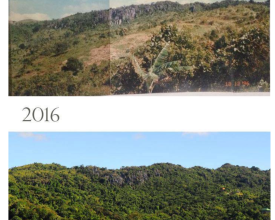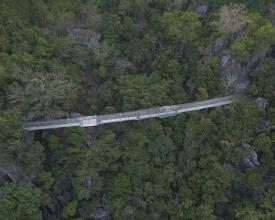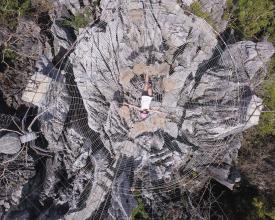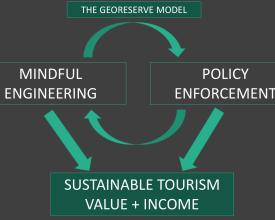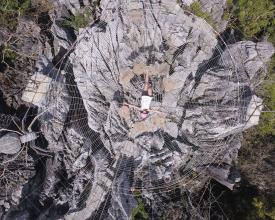
The Georeserve Model: Mindful engineering as a means to build sustainable tourism value and income in conservation areas
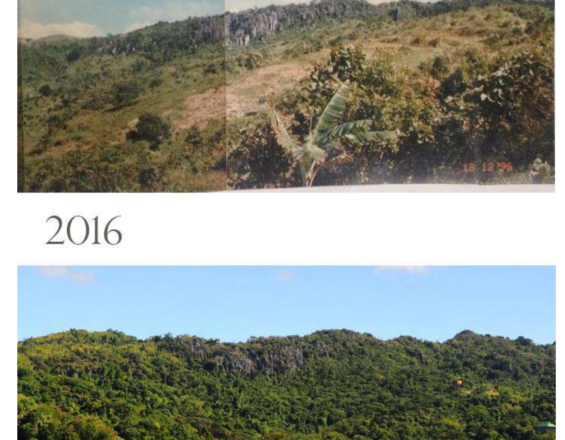
The georeserve model is a trademarked innovation demonstrated at the Masungi Georeserve conservation area in Baras, Rizal, Philippines. It has been proven to provide sustainable income for the management of the 430-hectare local conservation area through innovative tourism and engineering.
Inspired by the UNESCO Geopark Model, the georeserve is a smaller-scale initiative in the Philippines encompassing the three pillars of conservation, education/research and sustainable development, plus design and engineering that enhances the touristic value of an area in a low-cost and low-impact way.
The Masungi Georeserve hosts more than ten of these engineering marvels that enhance the natural character of the area: these include the Sapot (a web-style viewing platform that uses biomimicry), the Duyan (dubbed as the longest hammock in the world) and the Sawa (a rope bridge that serves as a rapid exit for visitors).
Context
Challenges addressed
- Environmental Challenges addressed: Systematic threats such as quarrying, mining, land speculation, unregulated development and illegal logging are thwarted. These are persistent threats since the conservation area is close to the highway and only an hour away from Metro Manila.
- Social Challenges addressed: We address the lack of jobs in the area besides contractual construction jobs. We address the lack of skills and education of the populace through trainings on leadership, first aid, customer service, environmental education, communications, as well as enterprise training on food and crafts. We address the lack of safe and drinkable water through our sanitary programs, where to date we have donated more than 200 water filters to households through the help of our partners.
- Economic Challenges addressed: We address the lack of financing for protected areas in the Philippines.
Location
Process
Summary of the process
The policy enforcement maintains the cleanliness, integrity, serenity, and natural character of the area by ensuring human disturbance is stopped before it could happen.
On the other hand, the design of mindful engineering marvels ensures human interaction is controlled and planned to help avoid disturbance to any sensitive areas in the conservation area.
Together they ensure that the cleanliness and integrity of the conservation area is protected, thereby ensuring long-term tourism value and income from satisfied visitors.
Building Blocks
Mindful Engineering
Mindful engineering, design and construction is a key component of this solution. For Masungi Georeserve, this means carefully planning the placement, material and method of constructing temporary structures inside the conservation area.
One method that is particularly evident at Masungi is the use of biomimicry or copying structures present in the natural environment. The iconic feature on our Discovery Trail is the Sapot, a local term for Spiderweb.
Instead of building a viewing deck made of concrete and foreign materials that would distract from the aesthetic of the place, we chose to build a web-style suspending viewing platform inspired by the webs of spiders found inside the conservation area.
In building this, we used light cable materials which can be removed, replaced or modified at any time, making the design resilient and adaptable to the area's changing environment.
In essence, mindful engineering means going beyond traditional ways of designing for touristic appeal. You do not need to copy what is already present in the market. You can get design inspiration from within, use local and sustainable materials, enhance the natural character of an area, and build a unique "sense of place" in the process.
Enabling factors
One important enabling factor is the design and construction skill from the team. Our craftsmen had years of construction experience and familiarity with the location before coming up with creative executions such as the Sapot.
Another enabling factor is research and exploration. To know where exactly to put these temporary structures, or which areas to highlight for tourism and educational purposes, the needs to be a baseline mapping and study of points of interest and how they connect together in one trail experience.
Lesson learned
- Give attention to details. At the end of the day, it is details that separate a good destination from a great destination.
- Use local materials and designs. This decreases carbon footprint of construction, as well as the cost and time needed to procure items.
- Find local talent. There is no need to hire expensive or already-known artists to create mindful structures. Even simple construction workers would have ideas on how we can be resourceful.
- Use nature are blueprint. Mirror designs already present in the area to create a unique sense of place.
Tourism Policy Enforcement
Policy enforcement is an important aspect of destination management that is often overlooked. In an emerging market such as the Philippines, many citizens are used to disobeying simple rules such as traffic and littering in the streets. Hence, an innovation we made for Masungi Georeserve is to make sure this habit does not penetrate into our sanctuary.
Policy enforcement is important in our overall solution because it ensures the structures and trails and engineering are properly and excellently maintaned and that the destination is always in pristine shape.
Policy enforcement comes in three phases: pre-trip, during the trip and after the trip.
Pre-trip, we are able to have an agreement with all visitors on the policies and corresponding penalties concerning their visit through our timed entry online booking platform. This includes policies of Leave no Trace, no smoking, no littering, no boisterous noise, no feeding of wildlife and no vandalism on our limestone formations.
During the trip, park rangers are not allowed to receive tips. This helps lessen any undue influence tips may have on the park ranger's ability to enforce the rules on the visitors.
After the trip, we ensure feedback is always given to visitors and our pakr rangers through evaluations and follow up communications.
Enabling factors
- Attention to developing skills of local rangers to implement rules. As many park rangers are from the local community, they need to be trained to enhance leadership and communications skills to be able to handle erring guests effectively.
- No tipping to prevent favors from guests.
- Online booking system to ensure policies are read, understood and agreed upon beforehand.
Lesson learned
We learned that it is better to implement and be strict with the rules despite possible resistance, as long as WHY of policies are communicated well.
We learned to put the lead contact (person who did the booking) responsible for all guests in the party. This increases accountability of the group and ensures one line of communication.
We also learned that it may be helpful to restrict access of middlemen - travel agencies and tour operators. We have come up with strict accreditation process in terms of operators and agencies who can sell the trail experiences at the Masungi Georeserve. This helps manage the overall experience, the visitor's expectations, and reinforce policies and values that the conservation area upholds.
Impacts
- Environmental Impact: After 20 of restoration from illegal logging, quarrying & land speculation, the georeserve now hosts more than 400 species of wildlife, many of which are rare & endemic to the Philippines. This includes the Giant Cloud Rat and Civet Cat, the Jade Vine and Hoyas, and numerous endemic birds, insects and amphibians. The 10-kilometer limestone formation of Masungi has been protected from constant quarrying and mining threats. In 2017, the Department of Environment and Natural Resources expanded the conservation area from 430 ha to more than 2,700 ha surrounding the georeserve.
- Social Impact: The georeserve now employs over 100 people, many of whom are local and several are part of the indigenous community. Previously illegal loggers and charcoal makers themselves, these park rangers are now the ones taking care of the forest and guiding people through the trails. Park rangers who join the georeserve double their income from the average income in their villages and receive social, health and housing benefits.
- Economic Impact: Thousands of visitors have already visited the georeserve since its opening on December 2015. This gave rise to the opening of food and drink establishments, lodging, as well as other community-managed nature hikes within the area. The total economic impact for the local economy can be estimated at more than $1 million dollars per year.
Beneficiaries
- Local communities and indigenous people
- Schools and educational institutions
- Local economy
- Conservation community in the Philippines through our community building efforts such as trainings, conferences and seminars
- Tourism community in the Philippines
Sustainable Development Goals
Story

The story of restoring our forests is already a colorful one. It is a product of 20 years of painstaking and selfless reforestation, as we used our very limbs and resources to protect our little piece of paradise against quarrying, loggers, and other destructive interests.
However, times have also changed. Despite progress in restoration, increased accessibility today meant bigger threats and bigger interest in destructive uses. This made us realise that our efforts needed to be more financially sustainable, and the place needs to be understood and appreciated by an audience bigger than our small group of stewards. The solution: to allow people inside.
There were three problems s in doing so: (1) mountains in the Philippines are being destroyed because of overtourism (2) there was a general preference for adventure activities over educational ones; and (3) there are many aesthetically similar karst landscapes nearby.
We found a solution to these through creative and mindful use of engineering in designing our educational trail experience. A few examples:
1. Visitor facilities allow guests to prepare adequately and before entering the trail. These help reduce human impact during the 4 hour trail and is a subtle showcase of the area’s unique feature such as bamboo and discarded snail shells.
2. Iconic & unique trail stops allow even beginner hikers to take rests along the hike. It also piques up their interest in natural elements that were previously unnoticed or unaccessible.
With the help of creative engineering practices, not only are we able to conduct tourism activities to sustain the area within its carrying capacity, but we were able to create pride of place, a better understanding of the areas's web of life, and provide direct sources of livelihood for over 70 community members in a remote location with limited livelihood opportunities.
